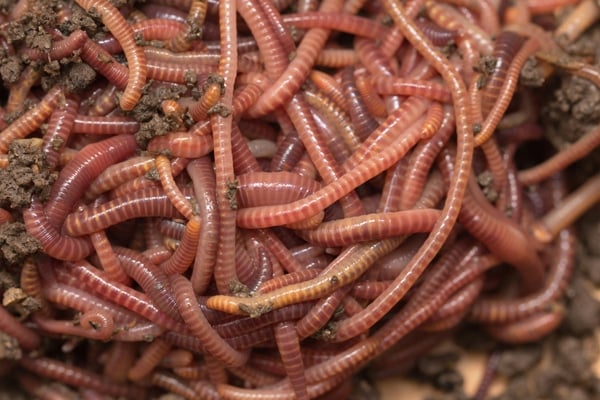Utilizing Red Wigglers for Effective Organic Waste Disposal
Making use of red wigglers for organic waste disposal provides an engaging method to handling food scraps while promoting environmental sustainability. These worms not only enhance waste decay but additionally yield important worm castings, which can substantially improve soil wellness. Their capacity to refine large volumes of organic product with marginal effort settings them as an obtainable option for houses and neighborhoods alike. However, comprehending the subtleties of establishing an effective worm bin and maintaining an optimum environment is essential for optimizing their advantages. The following steps in this process may amaze you.
Advantages of Making Use Of Red Wigglers
Among the most engaging advantages of utilizing red wigglers for organic waste disposal is their exceptional efficiency in composting. These worms, clinically recognized as Eisenia fetida, are particularly adjusted for breaking down organic materials, enabling them to process waste up to twice their body weight every day. This fast decomposition not just accelerates the composting process yet additionally generates nutrient-rich worm spreadings that substantially enhance soil quality.
In addition, red wigglers add to a reduction in garbage dump waste. By drawing away organic products from landfills, they assist lessen methane exhausts-- a potent greenhouse gas. This environmental advantage is essential in the battle versus climate change.
Furthermore, red wigglers are low-maintenance and can thrive in numerous atmospheres, making them available for both novice and skilled composters. Their capacity to reproduce swiftly makes sure a steady populace, helping with recurring waste processing.
Establishing Up Your Worm Bin
Creating a reliable worm container is necessary for making the most of the advantages of composting with red wigglers. Make certain the bin has adequate drain openings to stop excess wetness, as red wigglers flourish in a wet yet not soggy environment.
(red wiggler compost bin)Following, prepare the bedding material, which works as the worms' habitat and food resource. Shredded newspaper, cardboard, and coconut coir are outstanding choices. Goal for a bed linen deepness of around 4 to 6 inches. The bin must be placed in a dark, temperature-controlled location, preferably in between 55 ° F and 77 ° F, to keep worm task.
As soon as the bin is established, present the red wigglers, allowing them to accommodate to their brand-new environment. It's important to keep an eye on moisture degrees and temperature level routinely. A properly maintained bin will not just support the wellness of the worms however also facilitate efficient disintegration of natural waste. By following these standards, you can develop a thriving community that adds to sustainable waste administration.
(purchase red worms)
What to Feed Red Wigglers
An understanding of the suitable diet regimen for red wigglers is crucial for preserving a healthy worm population and optimizing composting effectiveness. Red wigglers flourish on a varied diet plan that primarily includes organic products. Perfect food sources include veggie scraps, fruit peels, coffee premises, eggshells, and shredded paper. These products not only provide necessary nutrients however additionally add to the wetness balance within the worm container.
It is critical to stay clear of specific foods that can harm the worm populace. Red wigglers ought to not be fed meat, milk products, oily foods, or refined products, as these can bring in parasites and produce undesirable smells. red wigglers. Furthermore, citrus fruits and spicy foods need to be minimized, as their acidity can be destructive to worms
Keeping track of the worm bin for food usage rates will certainly assist ensure that red wigglers are receiving an adequate diet regimen while maintaining a reliable composting atmosphere. Appropriate feeding methods are essential for cultivating a flourishing ecological community within the worm bin.
Maintaining Your Worm Habitat
A well-kept worm habitat is essential for the health and productivity of red wigglers. To make sure optimum problems, it is important to check temperature level, moisture, and aeration within the worm container. Red wigglers thrive in a temperature series of 55 to 77 degrees Fahrenheit. Exceeding this range can worry the worms, so it's vital to put the bin in an appropriate place away from direct sunlight and extreme temperature levels.
An excellent rule of thumb is to maintain moisture at around 70% to 80%. If the bed linen comes to be also wet, it can lead to anaerobic conditions that are harmful to the worms.

Utilizing Worm Spreadings in Gardening
Rich in nutrients and valuable microbes, worm castings serve as an extraordinary natural fertilizer for horticulture. Created via the digestive system procedures of red wigglers, these spreadings consist of a range of vital nutrients, including nitrogen, phosphorus, and potassium, which promote durable plant development. Unlike artificial plant foods, worm spreadings supply a slow-release mechanism, guaranteeing that nutrients are available to plants over an extensive duration, thereby reducing the threat of nutrient leaching and soil deficiency.
In enhancement to nutrient material, worm spreadings boost dirt framework and aeration, enhancing wetness retention and drainage. The microbial life present in worm castings helps to reduce virus and promotes a healthy and balanced dirt ecological community, more profiting plant health and wellness. When incorporated into the soil or made use of as a leading dressing, worm spreadings can significantly increase seed germination prices, origin development, and total plant vigor.
For ideal results, gardeners ought to use worm spreadings at a rate of 1-2 inches per square foot, mixing them into the dirt or integrating them right into potting mixes. On the whole, making use of worm castings is an environment-friendly approach to improving dirt fertility and making sure thriving garden settings.
Final Thought
